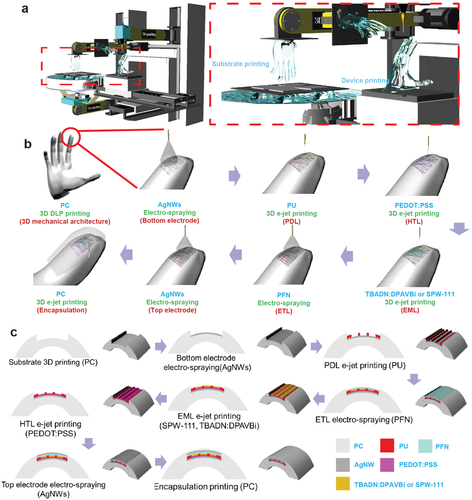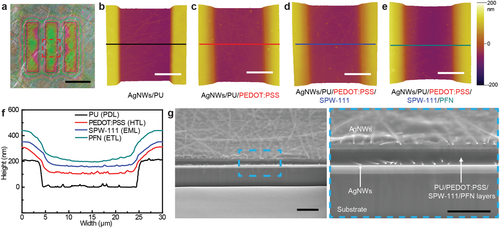In the recently published ‘High-Resolution 3D Printing of Freeform, Transparent Displays in Ambient Air,’ researchers from Korea are studying complex geometries in the form of optoelectronic architectures. If you are not familiar with such work, you may be surprised to find out that that such structures have been studied extensively in the past few years.
In most cases, optoelectronic devices with 3D structures must be created with stacks of 2D device layers, with interconnections woven in via wire or metal; however, ‘stacking’ can result in limitations, constraining more complicated device shapes.
“Overcoming this limitation potentially could result in significant applications beyond improving the scalability in device integration technologies. For instance, the ability to seamlessly incorporate optoelectronics into 3D structures could impart enhanced functionalities to these devices, such as advanced optical, electrical, and mechanical properties,” stated the researchers.
Direct 3D printing has the potential to eliminate some barriers, including different forms such as:
- Direct ink writing
- Digital light processing (DLP)
- Selective laser sintering
- Fused deposition modeling
- Inkjet printing
Such technology can be used in the following applications:
- Electronic circuits
- Batteries
- Photonic structures
- Optoelectronic devices
By creating a hybrid 3D printing system, the researchers can use DLP and electrohydrodynamic jet (e‐jet) printing to create transparent plastic frames. With e-jet printing, high‐resolution organic light‐emitting diode (OLED) pixels can be printed onto the mechanical frames. High resolutions can be printed, and the researchers point out that this is the case even with more ‘diverse geometries.’ Optoelectronic devices can be fabricated in a series, to include 3D mechanical frames and all OLED layers. No added thermal drying/annealing steps are necessary
“Although previous approaches on flexible/stretchable devices required the use of substrates and, therefore, must be attached only onto the surface areas of nonplanar objects, this hybrid 3D printing system can embed optoelectronic devices inside arbitrarily shaped 3D architectures selectively at desired locations instead of the surface regions, because all of the devices and mechanical frames are printed together as freeform optoelectronics,” stated the authors.
“Demonstrations of various 3D architectures, which include high‐resolution OLED pixels inside the architectures and a transparent, eyeglass‐type display for a wireless, augmented reality system, provide examples of the applications of this hybrid 3D printing system and indicate the future promise of freeform 3D optoelectronics.”

Schematic illustration of the hybrid 3D printing system and fabrication. a) Schematic illustration of the hybrid 3D printing system. b,c) Schematic illustration of the overall printing process for transparent 3D OLED devices
The e-jet printing system is comprised of:
- Metal-coated nozzle connected to a syringe
- Computer-controlled power supply
- Pneumatic pressure controller
- Translational stage controlled with five-axis movements
A key advantage is that this system can fabricate entire parts, along with ‘arbitrary-shaped plastic frames.’ Optoelectronic devices are embedded inside 3D architectures, becoming ‘freeform optoelectronics.’

Transparent OLEDs on various 3D architectures. a) Schematic illustration of the transparent OLED structure. b) Optical micrographs of EL emission from the fabricated OLEDs with TBADN:DPAVBi (top) and Merck White (bottom). Scale bars, 100 µm. c) Current density versus voltage curves of the 3D e‐jet‐printed OLED device with TBADN:DPAVBi (black) and Merck White (red). d) Luminance versus voltage curves of the 3D e‐jet‐printed OLED device with TBADN:DPAVBi (black) and Merck White (red). e) Normalized EL spectrum of the TBADN:DPAVBi (black) and Merck White (red). f) Optical transmittance spectrum of the 3D‐printed PC substrate, TBADN:DPAVBi, and SPW‐111‐based transparent OLEDs. g–j) Photographs of the 3D‐printed transparent OLEDs in turn‐off (left) and turn‐on (right) condition: g) cup of glass, scale bar, 5 mm. h) lotus leaf dish, i) round shape lamp, and j) human hand. Scale bars, 1 cm.
“Although previous works have been limited to printing only a few components of OLED devices on flat substrates, our approach allows the printing of all components of the device and the mechanical frames in ambient air. This allows transparent OLED pixels to be embedded inside the freeform 3D architectures at desired locations,” concluded the researchers. “Also, the integration of these transparent and freeform displays with wireless communication circuits demonstrates their substantial progress for use as augmented reality systems.
“These process improvements, together with exploration of applications in biotechnology and other areas, represent promising areas for future work.”
3D printing has offered enormous impacts to the realm of batteries and energy storage, electronic circuits, optics, and so much more. What do you think of this news? Let us know your thoughts! Join the discussion of this and other 3D printing topics at 3DPrintBoard.com.

Examples of applications of the 3D‐printed transparent OLEDs as augmented reality eyeglasses. a) Schematic illustration of the 3D‐printed augmented reality eyeglasses. b) Luminance versus current density curve of transparent OLED in augmented reality eyeglasses. c) Photographs of demonstrated augmented reality eyeglasses in turn‐off (left) and turn‐on (right) condition. Scale bars, 5 mm.

Examples of applications of the 3D‐printed transparent OLEDs as augmented reality eyeglasses. a) Schematic illustration of the 3D‐printed augmented reality eyeglasses. b) Luminance versus current density curve of transparent OLED in augmented reality eyeglasses. c) Photographs of demonstrated augmented reality eyeglasses in turn‐off (left) and turn‐on (right) condition. Scale bars, 5 mm.
Subscribe to Our Email Newsletter
Stay up-to-date on all the latest news from the 3D printing industry and receive information and offers from third party vendors.
You May Also Like
US Army Corps of Engineers Taps Lincoln Electric & Eaton for Largest 3D Printed US Civil Works Part
The Soo Locks sit on the US-Canadian border, enabling maritime travel between Lake Superior and Lake Huron, from which ships can reach the rest of the Great Lakes. Crafts carrying...
Construction 3D Printing CEO Reflects on Being Female in Construction
Natalie Wadley, CEO of ChangeMaker3D, could hear the words of her daughter sitting next to her resounding in her head. “Mum, MUM, you’ve won!” Wadley had just won the prestigious...
Blue Laser-powered M600 3D Printer Launched by Meltio
Founded in 2019 as a joint venture between Additec and Sicnova, metal 3D printer OEM Meltio develops and manufactures high-performance and easy-to-use metal 3D printing solutions that use its patented wire-laser metal...
3D Printed Storage Tanks Cut Material Costs by 25%
In a previous article, “Concrete Dreams: Let’s Print Money, Not Houses,” we discussed how the spotlight on 3D printing homes might be misplaced. Bollards, pedestrian bridges, and concrete tanks could...





























